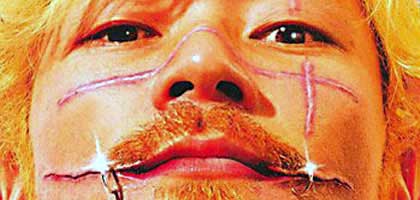
Ichi the Killer
Japan 2001

Reviewed by Tony Rayns
Synopsis
Our synopses give away the plot in full, including surprise twists.
The Kabuki-cho district of Shinjuku, Tokyo. Gang boss Anjo is messily slaughtered while visiting a prostitute. The assassin is the mild-mannered, self-pitying Ichi (Nao Omori), working under the hypnotic control of Jijii (Shinya Tsukamoto), who plans to decimate the Sanko family of yakuza gangs including the district's Anjo and Funaki gangs. Jijii and two assistants clean up the murder scene, leaving Anjo's lieutenant Kakihara (Tadanobu Asano) baffled by the disappearance of his boss. Kakihara (who enjoyed a very close sadomasochistic relationship with Anjo) mobilises the entire gang - later supplemented by the twin private eyes Jiro and Saburo to track down their missing leader.
Posing as an ally, Jijii tells Kakihara that the Funaki gang is implicated in Anjo's disappearance. Kakihara seizes Funaki's lieutenant Suzuki and tortures him with extreme sadism for information. Forced to apologise for this breach of yakuza etiquette, Kakihara cuts out his tongue and presents it to Funaki. While his tongue regenerates itself, Kakihara enlists Anjo's sometime girlfriend Karen, a bargirl at the Hirando Club, to follow further leads. A drug connection takes them to Jijii's assistant Kano; suffering cold turkey and under vicious torture, Kano names Ichi as the killer.
As Jijii sends Ichi to slaughter more members of the Anjo gang, Kakihara realises that Ichi will eventually come for him and relishes the prospect of the confrontation, which he foresees will bring him the orgasmic death he has always craved. Karen fails to satisfy Kakihara's masochistic needs and turns to Jijii, who reveals the fake memories he has planted in Ichi's mind to motivate his murders. Fascinated, Karen intercepts Ichi, posing as a rape victim he believes he once rescued; but her tactics backfire and Ichi slices her to death. Kakihara, now down to his last four men (they include the ex-cop Kaneko, whose lonely son Takeshi has befriended Ichi), tortures the Chinese pimp Long for a lead. But Ichi closes in, luring Kakihara and Kaneko to a final, ambiguous confrontation in which everyone except the boy Takeshi appears to die.
Review
The BBFC has passed Ichi the Killer with far fewer cuts than any previous administration would have made, but its extensive trims (all involving ultra-violence, of course, most of it against women) none the less deprive the film of some of its power. The 129-minute uncut version (screened in the London film festival and soon to appear on an unrated DVD in the US) has several images which invariably elicit loud moans of disbelief from audiences, and the film needs those moments of outrage as much as Bataille's Histoire de l'oeil needs its blasphemous, eye-gouging climax. If it doesn't reduce the viewer to quivering jelly, it's not doing its job. The UK version may be strong enough to fell first-timers, but anyone who has seen the integral version is bound to find this slightly tame.
Miike calibrated the film's outrage factor very precisely as he was forced to tone down or omit many of the original manga's most extreme climaxes. The 33-year-old Hideo Yamamoto (no relation to the film's cinematographer, who just happens to have the same name) published the original as a serial in the manga magazine Weekly Young Sunday in 2001, and it was immediately collected in a ten-volume anthology. It contains numerous images of male sexual excitement which are essentially unfilmable, at least as live action. To give just one example, in the original Kakihara unequivocally dies at Ichi's hands after a razor slash has stripped him of all his clothes and the bondage rig he wears beneath them and bisected his over-excited phallus lengthwise. Of course, questions of feasibility aside, Miike was also constrained by Japan's own censorship code, which permits all imaginable acts of sex and violence in any combination but still quaintly prohibits the exposure of genitals in a sexual context.
Working for the first time with the absurdist writer Sakichi Sato (they have since teamed up again on the slow-burn yakuza ghost story Gozu), Miike has remained remarkably faithful to the letter of Yamamoto's manga while pushing its implications into a different (and more sophisticated) direction. The manga is essentially a red-light-district gang-war vignette, garnished with ultra-violent fantasies about what really turns men on. It has a rather banal cyclical structure, ending with a coda showing the boy Takeshi growing up to become the new Ichi and the cycle beginning again. From this Miike and Sato have extrapolated the storyline, many specific episodes and the general tone of jet-black comedy, but they have completely rethought the ending to play up the existential and metaphysical dimensions. The film is less a gang-war thriller than an exploration of the implications of twinning.
Here the ultra-masochist Kakihara and cry-baby killer Ichi are explicitly doppelgangers. Ichi, the ordinary boy with ordinary sexual inhibitions, becomes under hypnosis the super-hero killer (to kill he wears black-leather body armour with a large yellow 'I' Ichi on the back) whose acts of extreme violence provide a painful sexual release. Kakihara, whose unrecounted history has taken him so far beyond conventional sexual satisfaction that he's on a different page entirely, seeks the ultra-sadist who can take him out on the ultimate high. Kakihara imagines that Ichi is his man, only to be confronted with a mirror image of his own pathology: ultra-sadism masking ultra-masochism. Their final confrontation is thus necessarily metaphorical and unresolved. The film's Kakihara in effect gives himself an auto-erotic climax by spiking his own brain through both ears, and then fantasises the attack by Ichi which finishes him off. Miike consolidates the ambiguity by providing a final image of Kakihara still apparently alive. Then a crow (substituting for the manga's sentimental dove) takes us past the corpse of Jijii (who has evidently hanged himself) to an anonymous boy in the crowd, whose fleeting gaze at the camera suggests with superb economy that anyone can be an Ichi.
Never one to let metaphysics get in the way of visceral provocation, Miike films this as a live-action cartoon, complete with gleefully cheesy CGI effects. For obvious reasons it's not really an actors' film, but it would add up to less than it does without the heroic contributions of an extraordinary cast, which includes the directors Shinya Tsukamoto and Sabu. Japan's indie star of the moment, Tadanobu Asano, often wasted in passive and reactive roles, here rises to the real challenge of a seemingly unplayable part. His Kakihara, decked out in the yakuza version of glam-rock costumes as he carves his way through all available male and female flesh, is one of cinema's greatest monsters.
Credits
- Director
- Takashi Miike
- Producers
- Dai Miyazaki
- Akiko Funatsu
- Screenplay
- Sakichi Sato
- Based on the comics in Shogakukan Weekly Young Sunday by
- Hideo Yamamoto
- Director of Photography
- Hideo Yamamoto
- Editor
- Yashushi Shimamura
- Production Designer
- Takashi Sasaki
- Music
- Karera Musication
